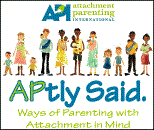Of course becoming parents changed our lives. Who knew it would also change our water bottles? But our increasing awareness of risks associated with exposure to BPA (inspired, of course, by Violet) led us to do exactly that. Our Nalgene bottles have been replaced by shiny new Siggs (non-leaching aluminum water bottles), and that was just the beginning.
Bisphenol A (BPA) is an industrial chemical used to make polycarbonate plastic resins (all number 7 plastics are polycarbonate and contain BPA), epoxy resins, and other products. Numerous studies have shown BPA to cause serious health effects, including cancer, diabetes, infertility, and behavior disorders, even at low doses. Mainstream media has covered the growing concerns over BPA and other toxins (like PVC and pthalates) in plastic - particularly plastic water bottles and baby bottles - extensively as of late. What isn't discussed as often are the other common items contaminated by BPA: for example, baby formula, canned food, and dental sealants.
According to Center for Disease Control (CDC) data, people are routinely exposed to unsafe levels of BPA from such sources. Not surprisingly, babies and children are the most vulnerable; their bodies' immature detoxification systems allow increased exposure to BPA which, according to the National Toxicology Program (NTP) brief on BPA could impact developing reproductive systems, hastening puberty and even leading to breast/prostate cancer, and affect behavior in children. It's scary stuff, and probably can't be avoided entirely, but there are alternatives to many of the major offenders.
Baby bottles. Most plastic baby bottles contain BPA, which is of particular concern because heating items containing BPA has been shown to increase the rate at which it leaches from the plastic by 55 times. Canada has actually banned baby bottles containing BPA from the market there. We have always used glass Evenflo bottles for Violet, but I understand there are BPA-free plastic bottles out there, too.
Food storage containers. Toxins in plastic food storage containers may leach into the food inside. This, too, is more likely if the container is heated, but even ordinary use and washing is sufficient to break down the plastic and allow leaching to occur. We avoid all number 7 plastics for our food storage, and all of Violet's food is kept and heated in glass. We're working toward replacing the rest of our Tupperware and Rubbermaid containers with glass storage pieces like Pyrex as well.
Canned food. Though the public eye has been focused recently on our exposure to BPA from plastic, BPA is also found in the lining of metal cans, where it leaches into the food or drink inside; independent studies have shown that exposure to BPA from such sources is significant. The EWG tested 97 canned foods and found that of all the foods tested, chicken soup, infant formula and ravioli had the most concerning levels of BPA: “Just one to three servings of foods with these concentrations could expose a woman or child to BPA at levels that caused serious adverse effects in animal tests.”
Though fresh, whole foods are always our first choice, we do rely on certain canned food staples like beans and tomatoes. Where other forms of items like these (for example, dried beans) aren't available or practical, we've switched to Eden Organic for almost all of our canned goods - they package their foods in a BPA-free can.
Dental sealant. Yes, that mysterious substance most of us have somewhere in our mouths contains BPA. And it's leaching out into our heads. What to do about that is less clear, as there don’t appear to be any safer options available for treating cavities. In a recent discussion with my dentist on the subject, I managed to talk my way out of a filling and into a crown. I guess that’s one way to avoid additional exposure to BPA, but I’m not sure I’d recommend it.













